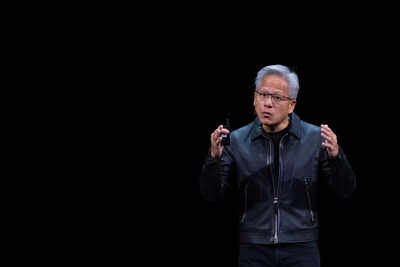While the scenario of a total ban appears extremely far-fetched, history shows that technology can become a weapon in geopolitical conflicts, especially in the case of leaders like Trump. The question is not whether this will happen, but whether India is prepared if it ever does.
The deep roots of dependence
India’s digital economy runs on American rails. Google powers most of our search and mobile ecosystems. Meta’s platforms — Facebook, Instagram and WhatsApp — dominate communication. Microsoft’s software underpins workplaces. Apple’s iPhones and app ecosystem shape consumer aspiration. Even X (formerly Twitter) remains the country’s main microblogging space for politicians, government, journalists and business leaders.
Beyond consumer apps, the dependence runs deeper, from cloud infrastructure to chip design and operating systems. As Vembu pointed out, the layers of reliance go far beyond the visible apps on our phones. Indian startups build their products on Amazon Web Services or Google Cloud. Nearly all smartphones run on Android or iOS. India has negligible presence in semiconductor manufacturing.

Live Events
This makes the idea of being cut off from U.S. tech unimaginable but not impossible. Technology has become a tool of statecraft, and nations increasingly weaponise it to advance geopolitical goals.
A reminder from history: When the U.S. cut off India
The notion that the U.S. might deny India technological access is not without precedent. During the 1999 Kargil War, India requested precise GPS data from the United States to locate infiltrating Pakistani troops. Washington refused. That moment of vulnerability directly led to India’s decision to develop its own navigation system, NavIC (Navigation with Indian Constellation).NavIC’s success stands as a reminder that dependence can be reduced when national interest and strategic urgency align. The same logic can apply to digital platforms and cloud infrastructure but the scale of the challenge is vastly greater.
The economic paradox
On the surface, it seems implausible that American companies would willingly cut off India. The country is the largest market for U.S. tech firms outside China, not for immediate revenue, but for long-term data and user base potential. India offers both the world’s biggest pool of internet users and a rapidly growing digital economy.
Moreover, these companies have made heavy local investments. Google has announced a $15 billion data center in Andhra Pradesh that will serve global operations. Apple is expanding its manufacturing footprint in Tamil Nadu and Karnataka. Meta and Microsoft employ thousands of engineers in India, and nearly every American tech firm has an R&D base here.
Any attempt by a U.S. administration to “switch off” India would not only be politically explosive but also economically self-destructive for these companies. Yet, as recent global trends show, geopolitics can override economics. Trump’s trade policies such as steep tariffs, tech restrictions and corporate arm-twisting have shown his willingness to use commerce as leverage. India cannot afford to assume that rational economics will always prevail.
China’s case: Self-reliance through control
China presents an illuminating but cautionary contrast. Long before global tensions escalated, it chose to insulate itself from American platforms. Facebook, Google and Twitter never operated freely in China. Instead, homegrown giants like WeChat, Baidu and Alibaba filled the vacuum, thriving in a protected digital ecosystem.
This strategy worked spectacularly in creating self-sufficiency but at a heavy cost. China’s digital autonomy came intertwined with state surveillance, censorship and information control. The same firewalls that protected Chinese companies also imprisoned citizens within a state-curated internet.
For India, a democracy that values open communication and global engagement, this model is impossible to replicate. The challenge, therefore, is to learn from China’s strategy of fostering local innovation without copying its authoritarianism.
The Indian way
India has already shown it can create large-scale digital infrastructure that rivals the best in the world. The Digital Public Infrastructure (DPI) model, exemplified by Aadhaar, UPI and ONDC, demonstrates how government-backed open systems can drive inclusion and innovation. UPI has revolutionised digital payments, while RuPay has successfully provided an alternative to Western giants Mastercard and Visa.
These platforms prove that India can build indigenous systems that compete globally, especially when they are public goods rather than private monopolies. The next frontier is to extend this success from infrastructure to mass digital platforms.
Vembu’s vision of a “National Mission for Tech Resilience” points toward this direction. The initial burst of enthusiasm for his Arattai app showed that Indians are willing to try local alternatives, but sustained adoption requires both quality and ecosystem support. Without policy backing, public incentives and consistent government use, homegrown platforms struggle to scale in the shadow of American giants.
The road to digital self-reliance does not lie in isolation, bans, or firewalls. It lies in strategic investment, public-private collaboration and nurturing an ecosystem where Indian platforms can compete globally on merit. The government’s role should be to provide the infrastructure and incentives, entrepreneurs must supply innovation and execution, and users must be willing to support local alternatives when they meet global standards.
The fear of being cut off by the U.S. may be fat-fetched, but it serves as a powerful reminder that digital sovereignty is not just about data localisation or regulation but also about the ability to stand independently if global alliances shift. India’s dependence on American tech may never be weaponised, but it remains a structural vulnerability. The lesson from both history and current geopolitics is that countries that rely entirely on external technologies risk losing agency when crises emerge.
India need not mimic China’s authoritarian firewall, but it must emulate China’s strategic foresight. With the talent, scale and policy momentum already in place, a decade-long national mission for technological resilience, as Vembu proposes, could turn a hypothetical fear into an opportunity for renewal. China sets a very limited example for India — the state help can go a long way in fostering tech resilience.







![[News] Nexperia Refuses to Guarantee China Chip Quality Amid Misconduct, Payment Row](https://koala-by.com/wp-content/uploads/2025/11/1762424662_Nexperia-20251014-624x416.jpg)
